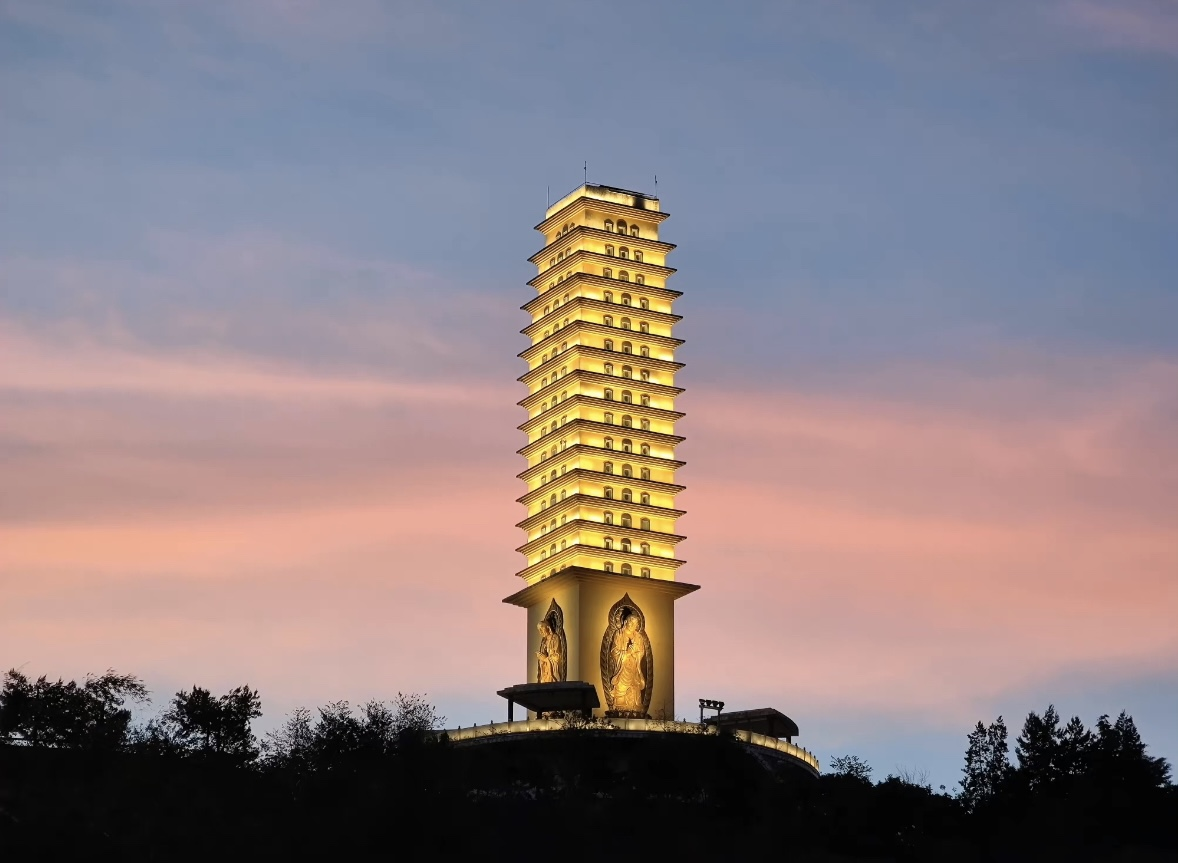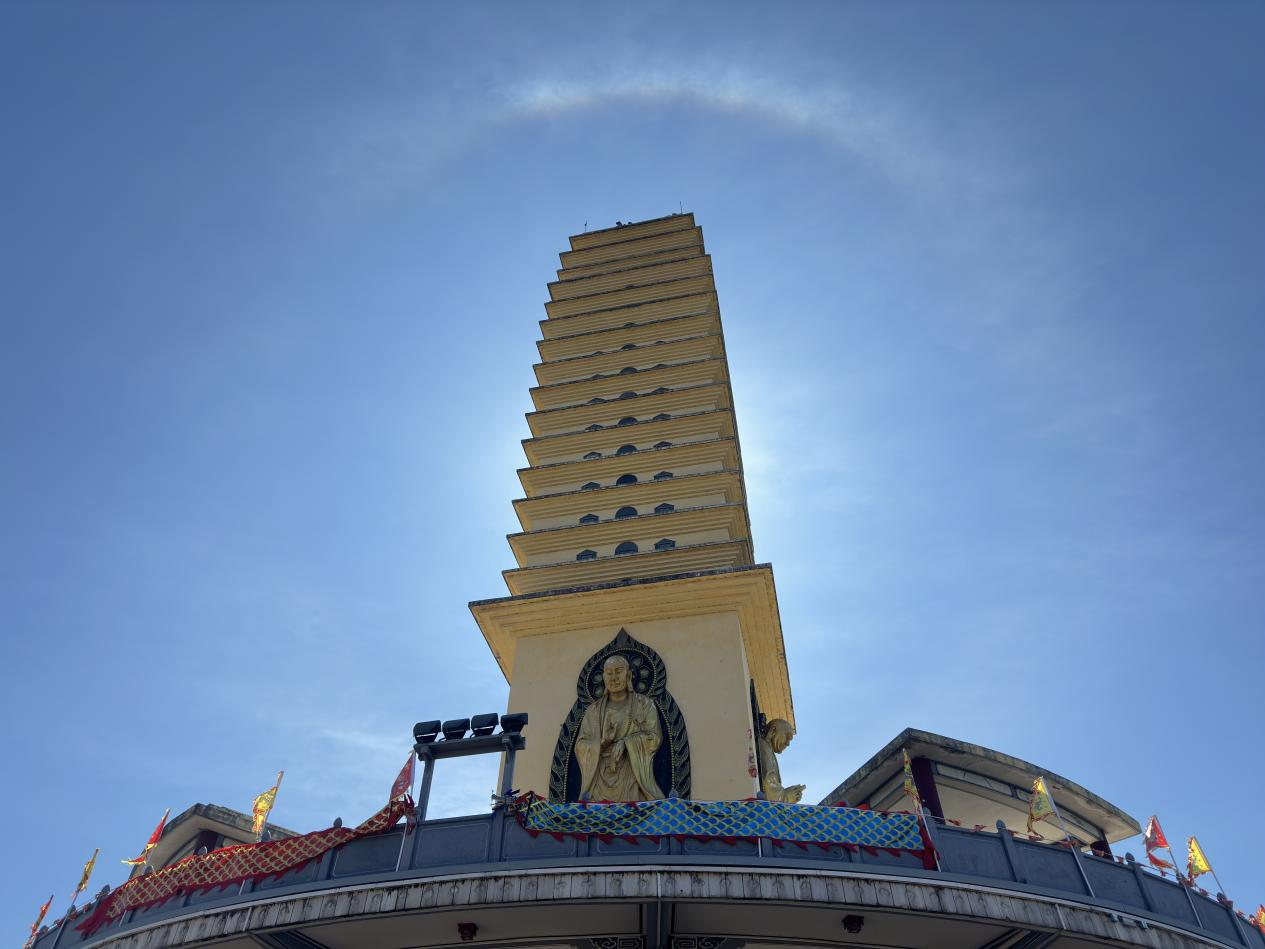Luoquan Pagoda
Behind Luoquan Temple, about 80 meters north of the newly built Tianjing Pavilion on the mountain ridge, stands an ancient tower without a spire, popularly known as the Topless Pagoda. Paired with the temple, the tower takes its name from the temple and is traditionally called the "Luoquan Pagoda". Like the main tower of the Three Pagodas Temple, known as the "Qianxun Pagoda" (its full name being "Fajie Tongling Mingdaocheng Pagoda"), it is extremely difficult to verify its original name. Guo Moruo, a scholar who was a historian, writer, poet, playwright, calligrapher, and archaeologist, visited Erhai Lake in September 1961 and also referred to the ancient tower as the "Luoquan Pagoda". His poem, "Erhai is truly a sea, the Luoquan Pagoda still exists," is now widely known. Sadly, less than five years after Guo Moruo's visit, the ancient tower was destroyed in July 1966 during the Cultural Revolution. Only a pile of rubble and some of the original Taihe stones used for the tower base—a type of riverbed stone from the eighteen streams of Cangshan Mountain—remain at the site.
Keyword:
Dali Luoquan
Luoquan Peninsula
Luoquan Pagoda
Tianjing Pavilion
Category:
Spot Description
Behind Luoquan Temple, on a mountain ridge about 80 meters north of the newly built Tianjing Pavilion, stands an ancient tower without a spire, popularly known as the "Topless Tower." Paired with the temple, the tower takes its name from the temple and is traditionally called the "Luoquan Tower." Like the main tower of the Three Pagodas Temple, known as the "Qianxun Pagoda" with its full name of "Fajie Tongling Mingdaocheng Pagoda," tracing the original name of this tower has become extremely difficult. Guo Moruo, a scholar who combined the expertise of historian, writer, poet, playwright, calligrapher, and archaeologist, visited Erhai Lake in September 1961 and also referred to the ancient tower as the "Luoquan Tower." Guo's poem, "Erhai is truly like a sea, the Luoquan Tower still exists," is now widely known. Sadly, less than five years after Guo's visit, the ancient tower was destroyed in July 1966 during the Cultural Revolution. The site now only contains a pile of rubble and some Tahe Yuan stones used for the tower's base – a type of riverbed stone from the eighteen streams of Cangshan Mountain.
The 1998 edition of the "Dali City Chronicle" entry on "Luoquan Tower" states: "The tower was approximately 25 meters high and 3 meters square, a multi-eaved square brick tower. It was destroyed in July 1966. The bricks have imprinted Sanskrit mantras and bricks with an inscription of 'Xin Wei Sui Zao' without a year. This tower was built during the Dali Kingdom period." Li Chaozhen and Zhang Xiluo's 1985 edition of "Ancient Towers of Dali," included in the "Nanzhao Ancient Towers" section, suggests that "the architectural style of the Luoquan Tower is similar to the Three Pagodas and Fotu Pagoda, and it is a building from the same era," describing it as "a thirteen-story, hollow, square, multi-eaved brick tower, with a remaining height of over thirty meters."
Why the tower was topless remains a mystery, with no relevant historical materials found to provide an answer. There is only a folk legend that seems somewhat instructive but clearly cannot truly explain the reason for its topless state.
Legend has it that in ancient times, a master and his apprentice competed to build a tower, seeing who could build faster and better. The master built the Three Pagodas in Haidong, and the apprentice built the Three Pagodas in Haixi, agreeing that whoever finished first would hold the Guanyin Market (later known as March Street) there. Unexpectedly, the master, being old and experienced, built meticulously, brick by brick. The apprentice, however, took shortcuts, using bamboo to build a framework and paper to cover it. For several days, there was no progress in Haixi. One day at dawn, the master looked towards Haixi from the East Mountain and saw that the apprentice's Three Pagodas had already been erected at the foot of Cangshan Mountain, while he had only just finished one of his towers. The master was very surprised and looked again. By then, it was broad daylight, and he saw clearly that it was made of paper. In a fit of rage, he struck the top of the tower with his palm, sending it flying to a village six li south. The more the master thought about it, the angrier he became. How could he have taken on such a dishonest, opportunistic, and deceitful apprentice? So he jumped into the sea and committed suicide. Legend says that later, the apprentice repented and rebuilt the Three Pagodas meticulously, and March Street was then set near the Three Pagodas in Haixi. But the apprentice never saw his master again. There is a village called Ta Cun (meaning "Tower Village" in Chinese) on the opposite shore of Jin Suo Island in Haidong; in Bai language, it's called "Ta Deng (taded)", literally translating to "Tower Head." It is said that the village got its name because the top of the Luoquan Tower fell there. Older people in the area say that there was indeed a small tower resembling a tower top behind Ta Cun in earlier years. The small hill where this small tower stood is also called "Ta Po" (Tower Slope) by the people of Ta Cun and Bo Xu villages.
Legends are just legends, and this is certainly not the real reason for the topless tower. Perhaps it was caused by an earthquake, perhaps the construction was unfinished, or perhaps this was simply a design feature. The true reason remains unknown, but hopefully, someone will uncover the mystery!
Those who have visited the Luoquan ancient tower recall that it was covered in moss and had no top. The lower level contained a stone statue of Buddha, which was then said to be the "Tower God." Hard sandalwood was inserted between the bricks of each layer. Because people often took the sandalwood to treat stomach aches and diarrhea, a corner of the bottom layer was damaged. Each of the four sides of each layer had a window.
According to Li Hao's "Three Yi Sui Bi" (Three Yi Essays) from the Ming Dynasty, it is said that "Luoquan lived to be ninety-six, dying peacefully, and a stupa was built for his relics on Yu'an Mountain... During the Dali Kingdom, the Luoquan Tower was destroyed by an earthquake." The "Record of the Rebuilding of Luoquan Temple and the Restoration of its Permanent Residence" from the twenty-eighth year of the reign of Emperor Kangxi of the Qing Dynasty states: "There is Luoquan Temple on the east coast of Ye Yu, founded by the Tang Dynasty monk Daoan... The monk rebuilt the tower on the mountaintop." The tower and temple were most likely built during the reign of Yimou Xun of the Nanzhao Kingdom in the Tang Dynasty. After the Battle of Tianbao, Ge Luofeng erected a stele in 776 to show that his rebellion against the Tang was unavoidable. In 779, Ge Luofeng died, and his grandson Yimou Xun succeeded him. The Tubo Empire re-appointed him as the "King of Ritedong," reducing the "brotherly nation" to a "subject nation." In 784, Yimou Xun moved the capital from Taihe to Dali (present-day Xizhou), and three years later, in 787, he moved it again to Yangjuma City (near present-day Dali Ancient City). The 'Xin Wei Sui Zao' inscription without a year on the brick may refer to the seventh year of the reign of Emperor Dezong of Tang, 791. This year was the fourth year since Nanzhao moved its capital from Dali to Yangjuma. Three years later, in 794, Nanzhao officially made peace with the Tang Dynasty and held the "Cangshan Alliance." The reason for the lack of a year is that Nanzhao had not yet officially submitted to the Tang Dynasty and it was inconvenient to write the Tang year name. Not writing the Tubo year name indicates that Nanzhao no longer wanted to be a subject of Tubo. The absence of a year is actually the key to uncovering the time the tower was built. If the ancient tower was indeed destroyed by an earthquake during the Dali Kingdom period, there would certainly be some intact bricks preserved. During restoration, these could have been reused, or replicas with the original 'Xin Wei Sui Zao' inscription could have been made. Perhaps the Luoquan stupa was not this tower, and the tower was not actually destroyed. The 1925 earthquake destroyed nine out of ten houses in the coastal area, yet this ancient tower remained intact. In 2005, during the construction of a water tower about ten meters north of the ancient tower site, another tower base was discovered during the clearing of the foundation, and many Tahe Yuan stones were unearthed. Whether the "double towers" mentioned in Li Jing's Yuan Dynasty poem "Tianjing Pavilion," "Double towers of hibiscus, jade majestic," were located here, and whether one of the double towers was later destroyed, leaving only the present "Luoquan Tower," is also possible. In short, there is little doubt that the tower was built during the Nanzhao Kingdom period of the Tang Dynasty.
The first entry in the Republic of China's "Haidong Chronicle: Famous Sights and Ancient Relics" lists "Three Pagoda Peak," with a note stating: "Located in Haidong, the main mountain of Luoquan Temple, the Three Pagodas still exist." "Three Pagoda Peak" refers to "the peak of Luoquan Mountain," which is undoubtedly true. However, only this ancient tower remains of the "Three Pagodas," and the "Xiangyang Pagoda" on the top of the elephant trunk peak of Yu'an Mountain, about seven or eight li away from this ancient tower, only makes a "double pagoda." Whether "Three Pagodas still exist" refers to the "Luoquan ancient tower" instead of the "Three Pagodas" of "Three Pagoda Peak" or something else is unknown.
All these mysteries are extremely attractive. If you are lucky enough to visit the Luoquan Peninsula, picking up a brick with Sanskrit writing or a brick with the inscription 'Xin Wei Sui Zao' without a year, or something else, is easy. If you are interested, go and see the ancient tower site; you will surely gain something.
The restoration of the Luoquan Pagoda is now on the agenda, with blueprints already completed. The pagoda will retain its original topless design, remaining a hollow brick pagoda with eaves, but the tower body will be taller than the original, with a 6-meter-high circular base. The circular base has a diameter of 23.6 meters, with a 3.6-meter-wide circular corridor surrounding it. Sixteen cylindrical pillars stand outside the corridor, surrounding a large, bright main hall. The pagoda body on the circular base is 36 meters high and has 16 levels. The base of the pedestal is 2 meters high, and the height from the pedestal to the first eave is 10 meters. The entire structure, including the tower body and base, is 42 meters high. The bright main hall in the center of the base has a total area of 216 square meters and can host large Buddhist events, regularly holding performances such as "Nan Zhao Feng Sheng Le". If the space is insufficient, all doors and windows can be opened to connect with the corridor. The hall's niches enshrine traditional Bai Mi Buddhist statues such as the Great Sun Tathagata and the Great Black God, with sculptures of the Eight Heavenly Dragons and other deities on the side walls. The tower body on the base features four Luoquan statues with different expressions ("joy, anger, sorrow, and joy"), with the image of Luoquan illuminating all directions. The Luoquan Pagoda will also feature carefully designed night lighting to highlight the vast magical power of Luoquan and the charm of the pagoda, recreating the scene described in the "Taiping Guangji" of "the pagoda emitting light." After the successful reconstruction of the Luoquan Pagoda, it will become the most distinctive pagoda in Dali Prefecture, combining a hall, pavilion, and pagoda, becoming the only three-dimensional multifunctional Buddhist site, the largest dojo of Bai Mi (A Zhaliji), and the most eye-catching and prominent landmark in the East China Sea region, comparable to the Three Pagodas of Chongsheng Temple in the West China Sea, adding to the beauty of the Cang'er scenery. It is said that the design also embodies the traditional Chinese philosophy of "outer circle and inner square" and the connotation of "heavenly mirror reflection," showcasing a brand-new look of the Luoquan Pagoda to visitors.
Recommended Attractions
Wind, Flower, Snow, Moon Pavilion
The First Pavilion of Erhai Lake - Tianjing Pavilion









